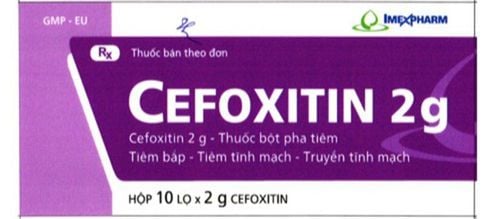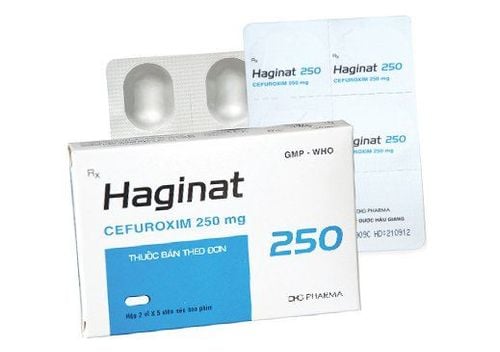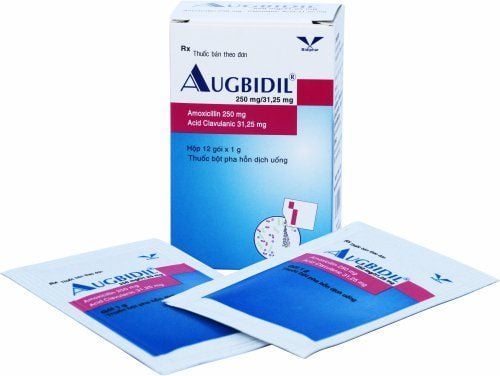This is an automatically translated article.
Cefusan is a prescription drug, an antibiotic group, with the main active ingredient being Cefuroxime. The drug is effective in the treatment of a number of infectious diseases such as sinusitis, pharyngitis, tonsillitis, lower respiratory tract infections,... Let's learn the uses of Cefusan through the article below.1. What is Cefusan?
The use of Cefusan in the treatment of infectious diseases caused by bacteria is due to the effect of the main drug Cefuroxime contained in the drug.
The drug belongs to the same class as the second generation cephalosporin antibiotics.
Pharmaceutical substance cefuroxime is a semi-synthetic broad-spectrum antibiotic, belonging to the group of cephalosporins, drugs in the form of axetil esters. Cefuroxime axetil is a prodrug of cefuroxime, which has little antibacterial activity when it has not been hydrolyzed to cefuroxime after being absorbed by the body. The drug has antibacterial activity by inhibiting the synthesis of bacterial cell walls by binding to essential target proteins (penicillin-binding proteins). Resistance is caused by bacteria secreting the enzyme cephalosporinase, or possibly by altering the penicillin-binding proteins. The drug has effective antibacterial activity, very specific against common pathogens, including beta-lactamase or cephalosporinase-producing strains of both gram-positive and gram-negative bacteria. The drug is particularly resistant to many types of beta-lactamase enzymes of gram-negative bacteria. After taking the drug, the drug is absorbed from the gastrointestinal tract, rapidly hydrolyzed in the intestinal mucosa and blood to release the drug cefuroxime into the circulation. Cefusan is best absorbed when taken with a meal. Maximum serum drug concentrations are reached approximately 2 to 3 hours after oral dosing with meals. The serum half-life ranges from 1 hour to 1.5 hours. The degree of plasma protein binding is shown to vary from 33% to 50% depending on the method used. Cefuroxime drug is not metabolized, is eliminated by glomerular filtration and by renal tubular secretion. Serum concentrations of cefusan are reduced by dialysis.
2. Indications and contraindications of Cefusan
2.1. Point
Cefusan is used in the following diseases:
Lower respiratory tract infections such as pneumonia and acute bronchitis and acute exacerbations of chronic bronchitis. Upper respiratory tract infections: Infections in the ears, nose, and throat such as otitis media, pharyngitis, sinusitis, tonsillitis. Genitourinary tract infections such as pyelonephritis, bladder infections, urethritis. Skin and soft tissue infections such as impetigo, boils, pus on the skin. Gonorrhea such as cervicitis, acute urethritis without complications due to gonorrhea.
2.2. Contraindications
Cefusan drug is not used in cases of known hypersensitivity, paresthesia to cefuroxime, cephalosporin antibiotics.
3. Dosage and how to take Cefusan
How to use: Cefusan is used orally, patients should take the drug during or after meals.
Dosage: The usual course of treatment is about 5 to 10 days.
Adults: Most infections: Dosage 500mg in 2 divided doses, 250mg each time. Typhoid fever : Daily dose 1000mg divided into 2 times, each time 500mg. Urinary-genital infections: Total dose of 250mg divided into 2 times, 125mg each time. Mild to moderate lower respiratory tract infections: Dose: 250mg each time, 2 times a day after meals. Severe cases, suspected pneumonia: Dose 500mg each time, take 2 times a day. Pyelonephritis: Oral dose of 250mg each time, 2 times a day. Uncomplicated gonorrhea: Single oral dose of 1 g. Early stage Lyme disease: 500mg each time, taken 2 times a day, for a total of 20 days. Children: Most infections: Dosage 125mg twice a day, maximum dose 250mg each time. Typhoid fever: 250 mg orally twice a day. Children 2 years and older with otitis media or serious infections: Dosage: 250mg each time, 2 times a day.
4. Undesirable effects when using Cefusan
Undesirable effects while taking Cefusan are usually mild and usually only last for a short time.
Skin signs such as erythema multiforme, skin rash, toxic skin necrosis, skin pruritus, urticaria, fever due to drug intake. Patients taking cefuroxime axetil have digestive disorders such as diarrhea, nausea, vomiting. As with other broad-spectrum antibiotics, there have been some (very rare) reports of pseudomembranous colitis as a side effect. Headaches have also been reported. Blood tests showed eosinophilia, transient elevations of liver enzymes ALT (SGPT) and AST enzyme (SGOT).
5. Notes during the use of Cefusan
Notes when the patient takes Cefusan antibiotics include:
The patient has a history of allergy to penicillin, when using the drug, it is necessary to inform the doctor about this allergy history. Patients who develop severe diarrhea after taking antibiotics should be noted for the diagnosis of pseudomembranous enterocolitis. Pregnant and lactating women should use Cefusan with caution and need to be examined and prescribed by a treating doctor. Above is information about the drug Cefusan. This is a cephalosporin antibiotic, used to treat infections caused by many bacteria that are still sensitive to the drug. Patients should not self-medicate, need a prescription and examination from a doctor. If you have any questions or concerns about Cefusan, please consult your doctor / pharmacist.













